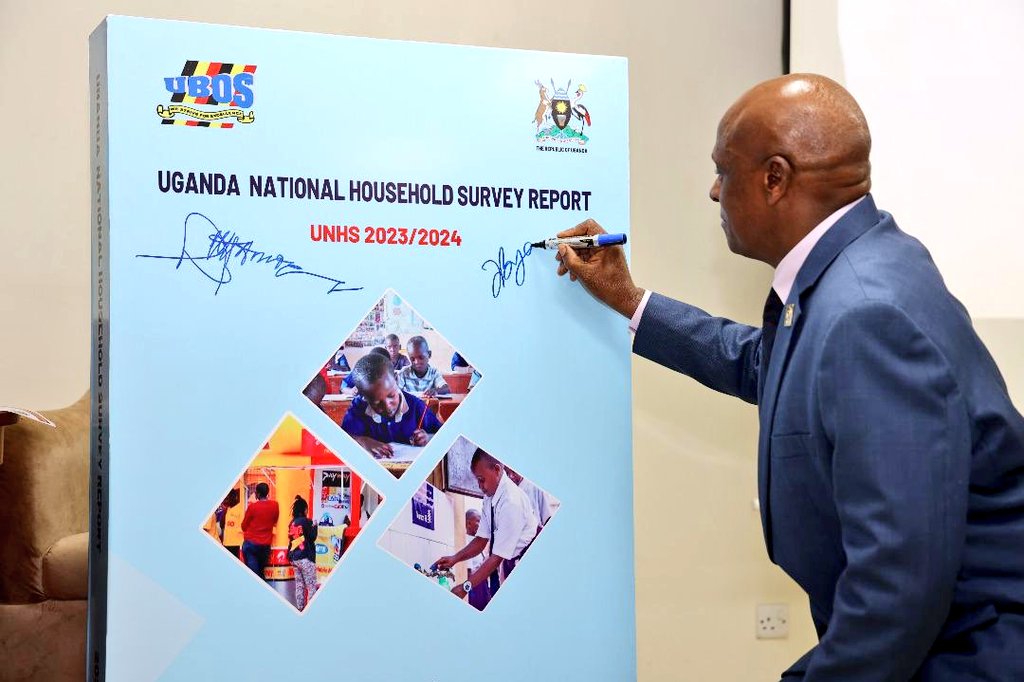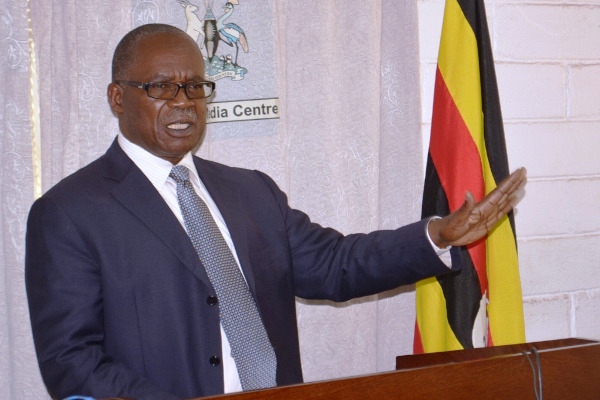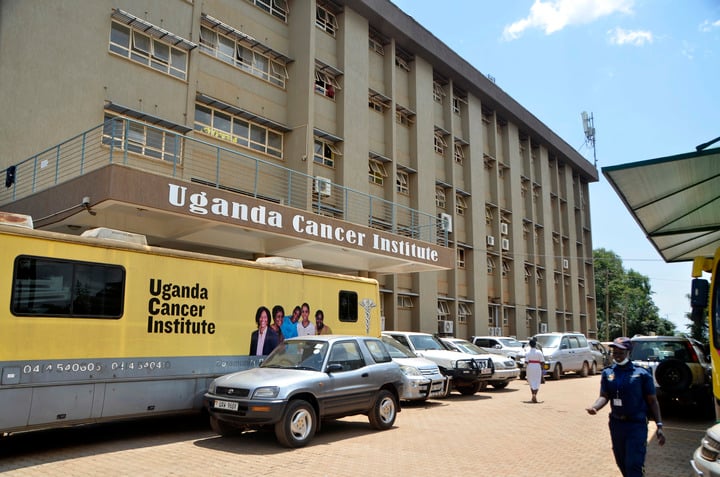With new data from UBOS, Uganda takes stock of progress—and outlines the path to an inclusive transformation
The Uganda National Household Survey (UNHS) 2023/24 released on 15th May 2025 at Hotel Africana in Kampala offers a comprehensive snapshot of how Ugandans live, work, learn, and access essential services. For businesses, policymakers, and development partners, this data is not just insightful—it is indispensable.

Uganda is a country on the move. With bold aspirations to deliver Vision 2040, the nation has set its sights on accelerated progress across education, health, employment, infrastructure, and income equality. But ambition alone isn’t enough. To chart a path forward, Uganda continues to depend on one of its most valuable national assets—the Uganda Bureau of Statistics (UBOS).
UBOS, with its consistent track record of delivering reliable and evidence-based data, has once again provided the country with a clear lens through which to evaluate progress. The Uganda National Household Survey (UNHS) 2023/24, released on 15th May 2025 at Hotel Africana in Kampala, offers a comprehensive snapshot of how Ugandans live, work, learn, and access essential services. For businesses, policymakers, and development partners, this data is not just insightful—it is indispensable.
This is the 8th Uganda National Household Survey. Previous Uganda National Household Surveys were conducted in 1999/2000, 2002/2003, 2005/2006, 2009/10, 2012/2013 , 2016/2017, 2019/20, and now 2023/24. Chris Mukiza, the UBOS Chief Statistician, said the survey collects high-quality data on the socio-demographic and economic characteristics of the household population for monitoring the socio-economic performance of the country in accordance with international and national development frameworks.
Key 2024 survey findings
There is good news. According to the survey, Uganda’s poverty rate has declined to 16.1%, down from 20.3% in 2019/20 and 21.4% in 2016/17. That translates into nearly one million Ugandans lifted out of absolute poverty within just four years. Income inequality has also improved.
The national Gini coefficient, a measure of income distribution where zero represents perfect equality, fell from 0.413 in 2019/20 to 0.382 in 2023/24, with key regions like Buganda South, Elgon, Karamoja, and Lango seeing the most notable reductions.
UBOS’ data also confirms that more Ugandans are getting closer to essential services. 91% now live within 5 kilometers of a health facility, up from 86% in 2016/17, and 82% of those who fell ill in the 30 days before the survey sought medical care—a signal of improving health-seeking behavior.
But as with any national data set, the averages can mask significant disparities. In Karamoja, 74.2% of the population lives below the poverty line, and a staggering 77.7% of children grow up in poverty. By contrast, Kampala’s poverty rate is only 1.1%, underscoring the wide regional imbalances that continue to define Uganda’s development narrative.
Education is another area where progress has stalled. Primary school net enrolment decreased to 77.9%, down from 80% in 2019/20, while secondary school net enrolment dropped to just 23.2% nationally. Rural areas fared worse, with only 16.7% of eligible children attending secondary school compared to 34.8% in urban areas.
The survey also sheds light on how Ugandans spend their money. Nationally, 44.2% of monthly household expenditure goes to food and non-alcoholic beverages—a figure that climbs to 52.3% in rural areas. Other significant spending areas include housing (15.9%), education (8.5%), and transport (6.2%).
Urban households allocate more of their budgets to education, communication, and housing—pointing to better access to services, but also higher living costs. In Kampala, for example, 21.5% of household expenditure goes toward housing, 11% to education, and 8.3% to transport.
Uganda’s economy continues to be driven by agriculture, which still employs 40.1% of the working population. However, the service sector has grown to become the dominant employer at 47.3%, especially in urban areas where services account for 63.9% of all employment. Yet rural Uganda remains heavily dependent on agriculture (55% employment share), pointing to the need for greater diversification and rural development if Uganda’s 10X agenda is to reach everyone.
UBOS delights in presenting factual data
In a world full of assumptions, UBOS provides the facts. The strength of the Bureau lies not just in the data it collects but in how that data powers decision-making across sectors. For businesses, UBOS data helps identify growth markets, guide investment decisions, and anticipate demand trends.
For government, it is the foundation for equitable policy and resource allocation. For development partners, it’s a roadmap for targeting programmes where they’re needed most. By maintaining methodological rigor—sampling over 17,350 households from 1,735 enumeration areas and achieving a national response rate of 92%—UBOS has proven once again that it remains the most reliable barometer of Uganda’s social and economic progress.
The statistics offer hope but also a warning. Uganda Vision 2040 can only become a reality if every Ugandan has access to transformation metrics (ATMs)—education, healthcare, food security, decent housing, and dignified work.
To accelerate progress, development partners must invest more strategically in regions like Karamoja, Bukedi, and Teso where poverty remains deeply rooted. Education interventions must go beyond enrolment to address quality, gender gaps, and dropout rates—especially in rural areas.
Health infrastructure must be expanded and financed to reduce out-of-pocket spending that still excludes the poor. Youth and women must be at the center of economic empowerment efforts through skills training and inclusive employment programs.
Data to guide transformation
Uganda’s ambition is clear. The roadmap is in our hands. Thanks to UBOS, the country knows where the gaps are and where the opportunities lie. The question now is not whether transformation is possible—it’s how fast we can make it happen. With data as our guide and collaboration as our fuel, Uganda’s Vision 2040 journey can move from promise to progress, from statistics to stories of real impact.
Uganda’s ambition to transform its citizenry from peasantry to a money economy, as enshrined in Vision 2040, is heavily reliant on a solid foundation of data-driven planning, the Minister of State for Finance, Planning and Economic Development (Planning), Amos Lugoloobi, emphasized during the launch of a survey. He underscored that evidence-based planning is no longer a desirable luxury but a fundamental necessity, the very “backbone of governance”.
The minister’s statement highlights a shift in perspective, recognizing that effective policymaking and resource allocation must be informed by reliable and comprehensive data. This recognition is particularly pertinent as Uganda implements the National Development Plan 4 (NDP4), a key strategic document driving the country towards its ambitious goals.
The NDP4, as Minister Lugoloobi explained, is deeply rooted in datasets derived from meticulous surveys and research. These datasets provide invaluable insights into the current socio-economic landscape, allowing policymakers to identify key challenges and opportunities and, ultimately, to develop targeted interventions that address the specific needs of the Ugandan people.
The commitment to data-driven planning extends beyond national aspirations, encompassing a dedication to global sustainable development goals. According to the minister, Uganda has successfully mainstreamed the Sustainable Development Goals (SDGs) into its local National Development Frameworks. This integration ensures that government investment priorities directly contribute to the achievement of these global targets, such as eradicating poverty, promoting quality education, and ensuring environmental sustainability.
By leveraging data, Uganda is able to tailor its development strategies to specific contexts, ensuring that investments are impactful and benefit the intended beneficiaries. This strategic approach allows for a more efficient allocation of resources, maximizing the return on investment and accelerating progress towards Vision 2040.







